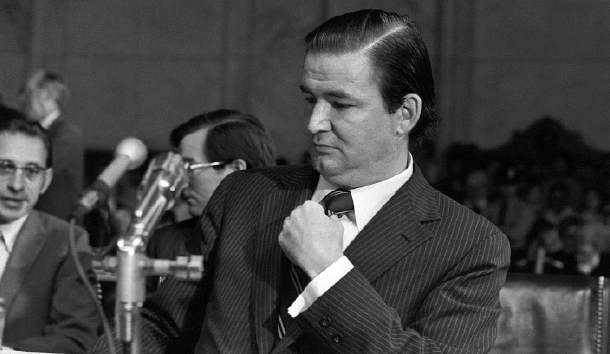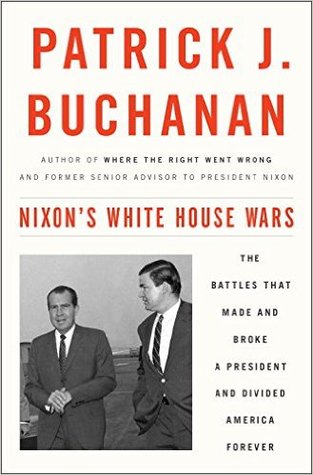Pat Buchanan’s new biography of Richard Nixon’s presidency is the first volume anyone looking at that tumultuous time should turn to. Having served as Nixon’s researcher and speechwriter starting in 1966, Buchanan, not yet 30, followed the victorious President into the White House in 1969.
In Nixon’s White House Wars, Buchanan makes it clear that Nixon’s tragic flaw was his inability to discard his liberal views on so many issues. At the 1964 GOP convention, Nixon “had been a portrait in loyalty when others abandoned” the conservative nominee, Barry Goldwater. “He had been at that Pickett’s Charge of the American Right. . . . He had money in the bank with conservatives who had been suspicious of him.” That conservative support won Nixon the GOP nomination in 1968.
Yet, instead of firing up the general election with fuel from the right, Nixon put in charge of his campaign Bob Haldeman, an adman who ran a bland campaign that barely beat liberal Democratic Vice President Hubert Humphrey. Once Nixon was in office, Buchanan writes, “I warned Haldeman of the problems certain to arise from the ‘para-military pyramidic structure’ he was setting up, to no avail. . . . Nixon had isolated himself, an isolation that would contribute to his downfall.” (Buchanan cites a Haldeman memo from 1973, as the Watergate scandal was intensifying, that “summed up how the West Wing looked on conservatives: We were an allied but irritable tribe, an ‘element’ that needed ‘pacifying.’” Yet it was conservatives who just had given Nixon his 49-state victory.)
“Our conservative critics were right,” Buchanan laments. Henry
Kissinger [a Rockefeller functionary] had shunted aside Dick Allen [future Reagan national security advisor], the foreign policy chief in the Nixon campaign. Henry wanted his own people at the NSC, loyal to him, as [liberal Democrat Daniel Patrick] Moynihan wanted his own people in his domestic policy shop. And both got them. . . . There was not an ideological conservative among Nixon’s West Wing assistants or Cabinet officers.
Later, Nixon gave Elliot Richardson, a liberal, three jobs: secretary of health, education, and welfare; secretary of defense; then attorney general. And numerous lower-level jobs went to liberals.
Buchanan became a talented infighter as a speechwriter and special assistant. He worked on the speechifying staff with, among others, William Safire, later the New York Times’ house “conservative” columnist, whom Buchanan describes as just another liberal publicist.
Buchanan was Nixon’s conservative conscience and the son he never had. A father often is exasperated by a talented son’s precociousness, but admiring nonetheless, and turns to him during times of crisis. Early on Buchanan realized he could phone Nixon directly about many issues, and Nixon often phoned him. As Nixon quipped, “Buchanan, you’re the only extremist I know with a sense of humor.”
Buchanan also used his writing talent to type brilliant memos to the President and staff that shaped policy, although the liberal bureaucrats often twisted his words their way in rewrites. “Nixon asked for and welcomed my missives,” Buchanan recalls. “It became our primary means of conversation.” (He sent more than a thousand of these.) Buchanan prepared the voluminous briefing books, sometimes distorted by liberal interjections, that Nixon pored over for days before the press conferences he loved to stage and where he sparred with leftist “reporters” such as Dan Rather.
As early as 1966, Nixon “had questioned [President] Johnson’s strategy in Vietnam, to which LBJ had responded in a tirade in an election eve press conference.” As Nixon assumed office in 1969,
Half a million U.S. troops were fighting in Southeast Asia, with thirty thousand dead, no end in sight, and caskets coming home every week carrying the remains of two to three hundred of the best and bravest of America’s young.
Why didn’t Nixon just end the war when he became President? As Buchanan explains, Nixon thought it would be dishonorable for America to lose a war. Doing so also would show weakness just as Nixon was planning major strategic moves toward Communist China and the Soviet Union. And Nixon actually did wind down the war, bringing home the troops over the next four years with his Vietnamization of the fighting force.
Unfortunately for the President and the country, those four years, following LBJ’s war escalation during the previous four, proved too much as the body bags continued to return, the liberal media persisted in attacking Nixon, the leftist protesters took over university campuses, and the nightly TV news showed bloody scenes from the field. Buchanan believes the war might still have been won had the Watergate scandal not propelled Nixon from office on August 9, 1974.
The war also played a part in Nixon’s downfall, beginning with the release of Pentagon Papers. An employee of the Defense Department, Daniel Ellsberg, stole voluminous departmental documents pertaining to the war and gave them to the New York Times and the Washington Post, which published them in a distorted manner most unhelpful to the war effort. The documents related only to the administrations of Presidents Kennedy and Johnson, but Kissinger insisted that to allow such a security breach would embarrass Nixon with the Soviets.
“[T]he White House decided to conduct its own investigation,” Buchanan recalls.
The individual the President wanted to oversee the investigation and head the White House unit that would come to be called the “Plumbers”—as its mission was to find and plug leaks—was me. . . . I turned it down. . . . My feeling was, let the law take its course, let the FBI handle this.
The Plumbers bugged Ellsberg’s psychiatrist’s office, which led to a scandal; later, they broke into DNC headquarters at the Watergate Hotel and Office Building and were apprehended, arrested, tried, and jailed. Pat Buchanan had nothing whatever to do with the Plumbers’ criminal acts.
As the Watergate investigation washed through the courts and Congress, it revealed that Nixon had taped many of his conversations in the Oval Office. Buchanan advised, “Burn the tapes.” The enigmatic President refused to do so. Pat laments, “Had Nixon followed my advice and burned the tapes, he would have saved his presidency and served out his term, and his reputation and place in history would not be what they are today.” Testifying before the Senate Watergate Committee, Buchanan electrified the country. The New York Times, Washington Post, and the national TV networks reported as a piece of “fake news” based on anonymous “sources” that he was the “architect” of the White House scheme involving “dirty tricks.” “Surely,” Buchanan notes, “the work of my basement inquisitors [on the committee’s staff] . . . was a hatchet job to smear me before I appeared before the committee.”
He kept punching, embarrassing his and Nixon’s enemies, against “an intellectual and political establishment” that included the media, the Ford Foundation, and the liberal Democrats, all part of “interlocking directorates,” all against “Mr. Nixon and his Middle American Constituency.” Newsweek described Buchanan’s performance as “a postgraduate seminar on advanced political strategy and tactics” conducted by a man “turned out like a pin-striped Irish pug spoiling for a fight.” Those five hours of testimony “made me a national figure,” Buchanan observes.
Among his regrets is that Nixon didn’t do more for Middle America, which instead suffered tax increases, inflation, the imposition of wage-and-price controls, the dictates of the Environmental Protection Agency and “Affirmative Action” programs, and the financial burden of funding Johnson’s Great Society. The immense expense of it all, paid for through tax increases and deficits, nagged the administration through the deep recession of 1974. Might a booming economy, the result of the administration’s adoption of free-market policies, have saved Nixon in the same way that such policies helped save Reagan during the 1986 Iran-Contra scandal?
Buchanan paints a pitiful picture of the “Old Man” as Watergate dragged on:
During this time, Nixon’s mood shifted back and forth. At times, he was full of fight; at others, he was not unlike a stage 4 cancer patient who has come to accept the inevitable—that he is not going to make it.
According to Buchanan, the President was severely damaged by transcripts of conversations between Nixon and White House Counsel John Dean, which “were crude and disgusting and read like transcripts of Mafia meetings and would kill the President with the country and Congress.” Buchanan suggested the White House itself put out the tapes, with its own explanation of what was involved. His plan was rejected.
Indeed, when numerous tapes were released on April 29, 1974, en masse and unaccompanied by context or explanation from the White House, they finished Richard Nixon. “I did not understand then, nor do I now, why we did what we did,” Pat writes. “What was hard for me to understand was the indecisiveness, the paralysis of a president who could act so boldly.”
The plan of action he sent to Nixon urged taking the offensive by halting abortion (in the wake of the Supreme Court’s unconstitutional Roe v. Wade), ending the busing of students across school districts, vetoing the legal-services program, and maintaining defense spending. “The idea was to get Nixon up and fighting again.”
Buchanan’s account of Nixon’s end begins with a tape of the President’s conversation on June 23, 1973, with Haldeman. Nixon, it came out, had checked the reel out from the tape library on May 6, 1974. The President, having listened to it on May 7, 1974, had rejected the offer by the special prosecutor, Leon Jaworski, to turn over 18 (rather than 64) specified tapes:
From then to August, the President had continued to speak of his noninvolvement in the Watergate cover-up in ways that seemed contradicted by the tape to which he had listened on May 6. . . . To me, this seemed almost conclusive proof that Nixon had known, at least for three months, that the case he had made to his allies in Congress and loyalists in the country was not entirely true. My conclusion: the President could not continue to lead a country he had asked to believe him, if he knew he had not been telling the truth. . . . Given our weakened condition, we could not survive this. . . . Nixon chose to put country and family first and end the agony.
There’s a great deal more than Watergate in Nixon’s White House Wars. Buchanan went along on the famous trip to China, where the first days “were exhilarating.” But in the days of Mao’s psychotic Cultural Revolution, “Peking began to appear as it was—a dim, grim, unhappy place.” Buchanan notes the irony of the American President, the secretary of state, and others raising toasts each night with Mao, the butcher of 60 million of his own people and the man who had murdered thousands of Americans in the Korean War as the communists “shipped to Hanoi the Soviet weapons killing U.S. soldiers in the South and U.S. pilots.”
He provides the details behind numerous important presidential speeches, covers Nixon’s four nominations (three of them hideous) to the Supreme Court, and the President’s support of Israel with a massive arms airlift during the 1973 Yom Kippur War, an action the author strongly supported. Buchanan provides a striking portrayal of Vice President Spiro Agnew, for whom he wrote hard-hitting speeches, and describes a drunken speedboat ride on the Black Sea with Nixon and Leonid Brezhnev.
As the subtitle indicates, the result of these crucial years was to “divide America forever.” As I finished the book, I found myself pondering how history might have differed had Nixon appointed a better staff: Buchanan, say, as chief of staff, Phyllis Schlafly as head of domestic policy, and Dick Allen as national security advisor. But it was not to be.

[AP Photo]
[Nixon’s White House Wars: The Battles That Made and Broke a President and Divided America Forever, by Patrick J. Buchanan (New York: Crown Forum) 448 pp., $30.00]

Leave a Reply